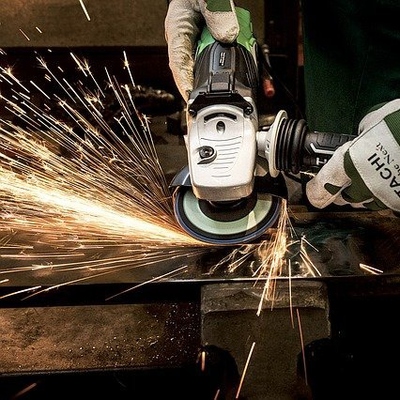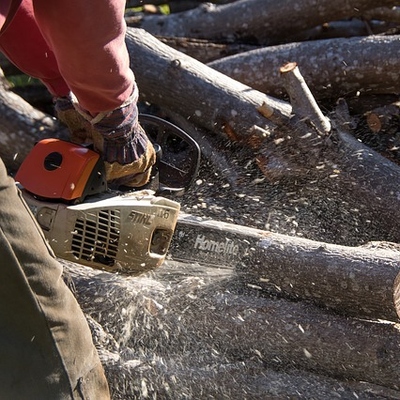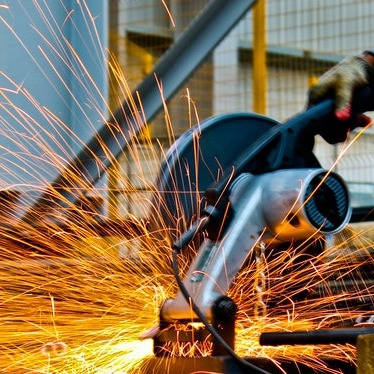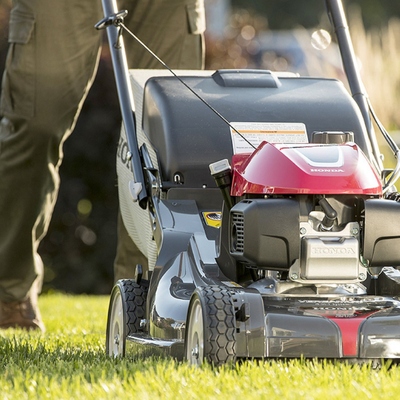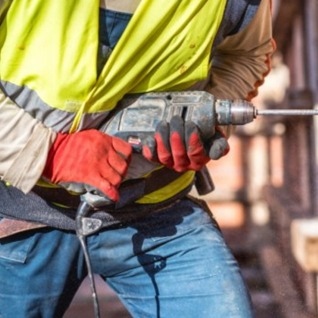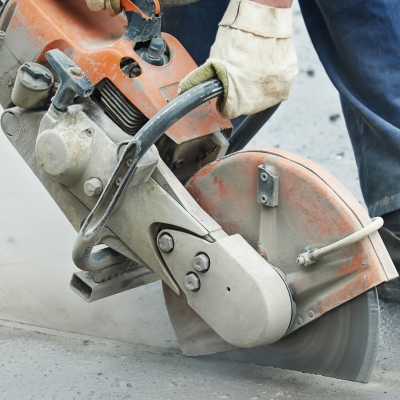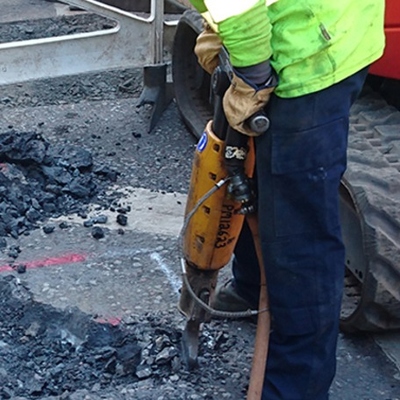What is Hand-arm Vibration Syndrome?
Hand-Arm Vibration (HAV) is the exposure of the hands and arms to vibrating surfaces. It can be caused by operating hand-held power tools, such as rock hammers and chainsaws, hand-guided equipment such as powered lawnmowers, or by holding materials being processed by machines, such as pedestal grinders.
Occasional exposure is unlikely to cause ill health. However, regular and frequent exposure to HAV can lead to Hand-arm Vibration Syndrome (HAVS) and Carpal Tunnel Syndrome (CTS).
Exposure to this type of vibration energy through the hand is known to cause irreversible damage to nerves, blood vessels, muscles and bones. Once the damage is done it is permanent.
The HSE estimates that 2m people in the UK are at risk of developing HAVS by using power tools at work. HAVS related illness is the highest reported RIDDOR.
The good news is that HAVS is preventable.
Key Facts about HAVS
Hand-arm Vibration Syndrome (HAVS) is the medical term for symptoms caused by damage that may occur in the fingers, hands and arms when working with tools, machinery or surfaces.
Neurological injuries
- Tingling/or numbness in the hands and fingers.
- Not being able to feel things properly
- Carpal Tunnel Syndrome (CTS)
Vascular injuries
- Blanching (whiteness) of the fingers (triggered by exposure to cold)
Musculoskeletal injuries
- Arthritis
- Tendonitis
- Loss of strength in the hands
- Reduced mobility
- Pain in the hand and arm
The effects of HAV exposure can seriously effect a person's ability to carry out tasks at work, at home and to do the hobbies they enjoy. Effects can include:
- Pain, distress and sleep disturbance
- Inability to do fine work (e.g pulling up a zip, holding a glass)
- Reduced ability to work in cold or damp conditions (which would trigger painful finger blanching attacks)
- Reduced grip strength which might effect the ability to do work safely.
The symptoms of HAVS and CTS may come and go, but with continued exposure to vibration they may become permanent. This can happen after only a few months of exposure, but in most cases it will happen over a few years. HAV Syndrome is irreversible, while CTS may be improved with surgery.
- Building and maintenance of roads and railways
- Construction
- Estate Management & maintenance
- Forestry
- Foundries
- Heavy engineering
- Manufacturing concrete products
- Mines & quarries
- Motor vehicle manufacture & repair
- Public utilities
- Shipbuilding & repair
- Chainsaws
- Concrete breakers / road breakers
- Cut-off saws (for stone etc)
- Hammer drills
- Hand-geld grinders
- Impact wrenches
- Jigsaws
- Needle scalers
- Pedestal grinders
- Polishers
- Power hammers and chisels
- Powered lawn mowers
- Scabblers
- Strimmers & bush cutters
How can HAVS risk be managed or reduced?
Reactec HAVS Prevention
Our HAV Management all-in-one ecosystem is specially designed to engineer the prevention of HAVS.
Learn how Reactec can helpWorkers at risk of contracting HAVS
People currently debilitated by HAVS
The short time it can take for symptoms to develop
CONSTRUCTION
Around 25% of all HAVS RIDDOR reportable incidents come from the construction sector. Add to that a tendency to rely on manufacturers' declared laboratory condition data and it is clear more representative assessments are needed.
MANUFACTURING
Nearly a quarter of all HAVS reportable incidents come from manufacturing. The incidence is highest for manufacturing of machinery, vehicles and transport.
RAIL
Over 90% of occupational health RIDDORs reported to the ORR are HAVS despite the 5 year plan launched in 2014 to eliminate new cases. Data shows an underestimate of exposure assessment in assumed vibration level.
UTILITIES
There are around 60 to 80 reports of HAVS within the utility sector each year amounting to nearly 1 in 10 of all reported RIDDOR incidents.
AGRICULTURE
In our latest study, around 15-20 people from the agriculture, forestry, fishing and veterinary industries are reported as being diagnosed with HAVS every year.
MOTOR VEHICLE REPAIR
The prevalence of HAVS within MVR is one of the very highest at over 1 per 1,000 employees. Varied work with prolonged period on tools calls for more stringent attention to controls.
Industry-specific White Papers
Our industry-specific papers set out to explain why HAVS continues to be a reason for skilled workers to be taken off the tools, as well as explain how technology can be used to manage your employees’ exposure and prevent irreversible damage effectively and inexpensively.
Key Evidence & Research
Legal HAV obligations & regulations
The Control of Vibration at Work Regulations 2005 Under these regulations it is an employers duty to eliminate or control vibration exposure risk to as low as reasonably practical (ALARP). Suggested actions include:
- An assessment of the risks to employees from exposure to vibration, including assessment of employees’ daily exposure to vibration.
- Information, instruction and training to tool users and their managers.
- Health surveillance when required
In 2019, the directors of a leading business were suspended following three workers being diagnosed with HAVS.
- £500k Recorded HSE fine in 2018
- £118k Single person claim against an employer
- 300% Rise in financial penalties relating to HAVS fines since new sentencing guidelines were introduced in 2016
BC Legal's analysis of changes in the 15th edition of the Judicial College Guidelines for the Assessment of General Damages in Personal Injury Cases (JC Guidelines) to previous

By law, an employer must assess and identify measures to eliminate or reduce risks from exposure to HAV to as low as reasonably practicable (ALARP).
- The purpose of assessment is to enable management of risk
- An assessment is adequate if it provides enough information to enable you to take the most appropriate action
- Helps to target highest exposure processes (biggest gains)
A key part of the assessment is an evaluation of exposure.Your evaluation should:
- Identify where there might be a risk from vibration and who is likely to be affected
- Contain a reasonable estimate of your employees’ exposure
- Identify what you need to do to comply with the law e.g. whether vibration control measures are needed, and, if so, where and what type
- Identify any employees who need to be provided with health surveillance
For each worker or task
1. Decide what needs to be assessed:
- Operating modes
- Accessories (bits, abrasive grades..)
- Postures, forces, environment
- Human factors - experience, motivation, fatigue
2. Take account of:
- Machines or tools used
- Materials worked
- Observe the process first and decide on your approach
- Ensure the assessment is typical of future work
- What tools are available to aid risk assessment
The HAV Exposure Points System
This is the points system devised by the Health and Safety Executive (HSE) to make assessing daily exposure to vibration simpler. It allows risk from using more than one tool type to be easily combined. Exposure expressed in points is simply added for each exposure activity.
For each exposure the points system combines the vibration magnitude during the exposure with the time of the exposure.
- The exposure action value (EAV - 2.5m/s2 A(8)) is 100 points
- The exposure limit value (ELV - 5m/s2 A(8)) is 400 points
- The HSE have published a calculator for you to enter specific exposure information into an excel type application and a ready reckoner to show graphically exposure within buckets of time and vibration.
Alternatively you can apply the following formula:
- Exposure points = 2 x T(exposure time in hours) x V(vibration magnitude in m/s2) x V(vibration magnitude in m/s2)
HAV Risk Assessment Management
Below are a series of five webcasts covering the topic on Hand-Arm Vibration (HAV) exposure risk ranging from what is Hand-Arm Vibration Syndrome and its causes and effects on employers and employees to exposure risk assessments, tool measurement and managing the risk including the hierarchy of controls, health surveillance and training.
The material used in the webcasts have been collected and compiled by Reactec with a number of leading health and safety professionals.
Who should view the webcasts?
These webinars are aimed at supervisor/manager level, those who are responsible for assessing, controlling and managing hand-arm vibration risk in the workplace.

